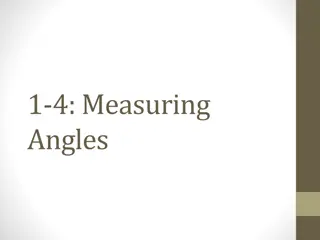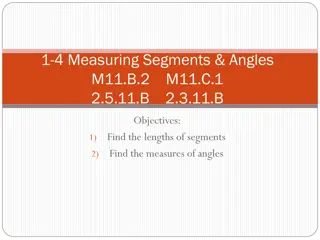Exploring concepts of equidistance and angle bisector in geometry
Explore the concepts of equidistance and angle bisectors in geometry through practical examples like determining the path for John to walk equidistant from a hedge and a wall, understanding the ideal flight path for a plane to land, constructing angle bisectors, and verifying constructions for accuracy.
Download Presentation

Please find below an Image/Link to download the presentation.
The content on the website is provided AS IS for your information and personal use only. It may not be sold, licensed, or shared on other websites without obtaining consent from the author. Download presentation by click this link. If you encounter any issues during the download, it is possible that the publisher has removed the file from their server.
E N D
Presentation Transcript
John is standing at the point marked with a red cross. He wants to walk so that he is always the same distance away from the hedge and the wall. Where should John walk? X
John is standing at the point marked with a red cross. He wants to walk so that he is always the same distance away from the hedge and the wall. How do you know he is exactly half way between the wall and the hedge? X
John is standing at the point marked with a cross. He wants to walk so that he is always the same distance away from the hedge and the wall. What would be the same if the path had been drawn perfectly? X
The ideal flight path for the plane to land is midway between the maximum and minimum angle of descent. What path should the plane take?
To draw the path accurately we can use a construction known as an angle bisector. What do you think the word bisector means? bisect: to split into two equal parts
When constructing an angle bisector every point on the path drawn is equidistant from one side as it is from the other. The angle has been perfectly cut in half.
Constructing an angle bisector Q P R Measure both angles. Are they the same?
Jane has attempted to construct an angle bisector of the following angle. How can we tell if Jane is correct or not?
Jane has attempted to construct an angle bisector of the following angle. Discuss: Where has Jane gone wrong?
Constructing an angle bisector Why do you think the exact width is not important?
Constructing an angle bisector Why do you think the compass width must remain the same?
Why do you think the compass width can change at this point? Why would it be sensible to keep it the same?
Angle Bisector Bisect each of the angles on the worksheet. You must leave in your construction lines
Challenge Problem: Bisect all 4 angles using the fewest arcs and lines. (Record: 4 arcs, 2 lines)
Can you use the diagram below to describe how the construction works? This construction works by effectively creating two congruent triangles. The image is the final drawing above with the red lines added and points A,B,C labelled.
Challenge Problem: Draw a triangle and construct the angle bisector of each corner You should find that the bisectors intersect at a single point inside the triangle! Now using the point of intersection as centre, draw the largest possible circle that does not leave the triangle You should find that the circle touches all three sides of the triangle This works with anytriangle Can you explain why this happens?!























